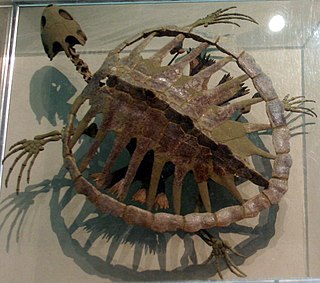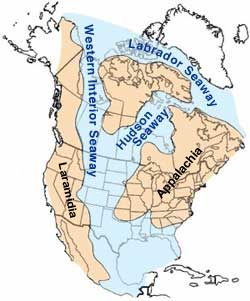
The Smoky Hills are an upland region of hills in the central Great Plains of North America. They are located in the Midwestern United States, encompassing north-central Kansas and a small portion of south-central Nebraska.

Polycotylidae is a family of plesiosaurs from the Cretaceous, a sister group to Leptocleididae.

Dolichorhynchops is an extinct genus of polycotylid plesiosaur from the Late Cretaceous of North America, containing three species, D. osborni, D. bonneri and D. tropicensis, as well as a questionably referred fourth species, D. herschelensis. Dolichorhynchops was an oceangoing prehistoric reptile. Its Greek generic name means "long-nosed face".

Brachauchenius is an extinct genus of pliosaurid that lived in North America during the Late Cretaceous.

The Geology of Kansas encompasses the geologic history of the US state of Kansas and the present-day rock and soil that is exposed there. Rock that crops out in Kansas was formed during the Phanerozoic eon, which consists of three geologic eras: the Paleozoic, Mesozoic and Cenozoic. Paleozoic rocks at the surface in Kansas are primarily from the Mississippian, Pennsylvanian and Permian periods.

The Smoky Hill Chalk Member of the Niobrara Chalk formation is a Cretaceous conservation Lagerstätte, or fossil rich geological formation, known primarily for its exceptionally well-preserved marine reptiles. The Smoky Hill Chalk Member is the uppermost of the two structural units of the Niobrara Chalk. It is underlain by the Fort Hays Limestone Member; and the Pierre Shale overlies the Smoky Hill Chalk. The Smoky Hill Chalk outcrops in parts of northwest Kansas, its most famous localities for fossils, and in southeastern Nebraska. Large well-known fossils excavated from the Smoky Hill Chalk include marine reptiles such as plesiosaurs, large bony fish such as Xiphactinus, mosasaurs, flying reptiles or pterosaurs, flightless marine birds such as Hesperornis, and turtles. Many of the most well-known specimens of the marine reptiles were collected by dinosaur hunter Charles H. Sternberg and his son George. The son collected a unique fossil of the giant bony fish Xiphactinus audax with the skeleton of another bony fish, Gillicus arcuatus inside the larger one. Another excellent skeleton of Xiphactinus audax was collected by Edward Drinker Cope during the late nineteenth century heyday of American paleontology and its Bone Wars.
The Tropic Shale is a Mesozoic geologic formation. Dinosaur remains are among the fossils that have been recovered from the formation, including Nothronychus graffami. The Tropic Shale is a stratigraphic unit of the Kaiparowits Plateau of south central Utah. The Tropic Shale was first named in 1931 after the town of Tropic where the Type section is located. The Tropic Shale outcrops in Kane and Garfield counties, with large sections of exposure found in the Grand Staircase-Escalante National Monument.
The Cody Shale is a Late Cretaceous geologic formation. It is mapped in Wyoming, Idaho, and Montana.
The Lake Waco Formation is a geologic formation within the Eagle Ford Group deposited during the Middle Cenomanian to the Early Turonian of the Late Cretaceous in central Texas. The formation was named for outcrops near Lake Waco, south of the city of Waco, Texas by W. S. Adkins and F. E. Lozo in 1951. The Lake Waco Formation is primarily composed of shale, with minor amounts of limestone and volcanic ash beds (bentonites). It is subdivided into three members: Bluebonnet Member, Cloice Member, and the Bouldin Member. The Bluebonnet Member is 10 to 20 ft thick, and is made up of broken pieces (prisms) of inoceramid clams and planktonic foraminifera. The Cloice Member is 35 ft thick at its type section on the Cloice Branch of the South Bosque River, whereas the Bouldin Member was named for outcrops on Bouldin Creek south of downtown Austin, where it is roughly 9 ft thick. They are both made up of shales rich in organic matter with thin limestones and volcanic ash beds.
The Britton Formation is a geologic formation deposited during the Middle Cenomanian to the Early Turonian ages of the Late Cretaceous in modern-day East Texas. It forms the lower half of the Eagle Ford Group in the northern portion of East Texas. The formation was named by W. L. Moreman in 1932 for outcrops on Mountain Creek near the small town of Britton, south of Dallas. In the Dallas area it has been subdivided into the Six Flags Limestone, Turner Park Member, and Camp Wisdom Member. The Six Flags Limestone is a 3 ft thick fossiliferous calcarenite made up of pieces (prisms) of Inoceramus clams. The Turner Park and Camp Wisdom Members were subdivided based on the numerous volcanic ash beds (bentonites) found in the Turner Park, and the common occurrence of concretions in the Camp Wisdom. They are approximately 120 ft and 250 ft thick in the Dallas area. Thin sandstones known as the Templeton Member are found in Grayson County, north of Dallas, that are age equivalent to the lower part of the Turner Park Member. The Templeton Member was originally described as a part of the Woodbine, but it was recently placed in the Britton Formation of the Eagle Ford Group based on its age as derived by ammonites. Plesiosaur remains are among the vertebrate fossils that have been recovered from its strata.

Collignociceras is a strongly ribbed and tuberculate, evolute ammonite from the Turonian of the western U.S. and Europe belonging to the ammonitid family Collignoniceratidae. The genus is named after the French paleontologist Maurice Collignon. The type is Collignoniceras woollgari, named by Mantell in 1822 for specimens from Sussex, England.

This timeline of plesiosaur research is a chronologically ordered list of important fossil discoveries, controversies of interpretation, taxonomic revisions, and cultural portrayals of plesiosaurs, an order of marine reptiles that flourished during the Mesozoic Era. The first scientifically documented plesiosaur fossils were discovered during the early 19th century by Mary Anning. Plesiosaurs were actually discovered and described before dinosaurs. They were also among the first animals to be featured in artistic reconstructions of the ancient world, and therefore among the earliest prehistoric creatures to attract the attention of the lay public. Plesiosaurs were originally thought to be a kind of primitive transitional form between marine life and terrestrial reptiles. However, now plesiosaurs are recognized as highly derived marine reptiles descended from terrestrial ancestors.

Megacephalosaurus is an extinct genus of brachauchenine pliosaurid plesiosaur known from the early Late Cretaceous Carlile Shale of Russell County, Kansas, United States. It contains a single species, Megacephalosaurus eulerti. It was one of the latest known member of Pliosauridae family.

The Greenhorn Limestone or Greenhorn Formation is a geologic formation in the Great Plains Region of the United States. It preserves fossils dating back to the Cenomanian and Turonian of the Late Cretaceous period.
The Benton Shale is a geologic formation in Montana, Wyoming, North Dakota, South Dakota, Colorado, Kansas, and Nebraska. It preserves fossils dating to the Cretaceous Period. The term Benton Limestone has also been used to refer to the chalky portions of the strata, especially the upper beds of the strata presently classified as Greenhorn Limestone. The Benton classification is obsolete in some regions, having been replaced by the ascending sequence Graneros Shale, Greenhorn Limestone, and Carlile Shale.
Juana Lopez refers to both the uppermost member of the Carlile Shale formation and to the environment that cause it to form. This unit is calcareous sandstone of Turonian age, Upper/Late Cretaceous series in the southern and western Colorado and northern and central New Mexico.

























